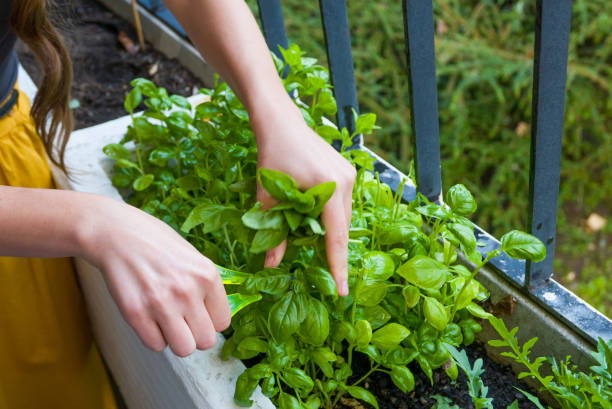
Herbal farming is more than a growing trend; it plays a significant role in our environment. Herbal plants, used for medicine and cooking, can affect our world in many ways. This article will explore how herbal farming impacts the environment.
We’ll examine its effects on soil health, biodiversity, water use, and greenhouse gas emissions. Understanding these aspects helps us make better choices for a greener future.
1. Soil Health
Herbal farming, in many regards, enhances the quality of soil. Unlike conventional crops that can demand robust use of synthetic fertilizers and pesticides, many herbs thrive with little chemical input. Lavender and mint herbs naturally improve the soil.
They provide organic matter through their roots and rotting leaves, improving fertility and soil structure. This organic matter increases the soil’s nutrient and moisture-holding capacity.
Herbal plants can also prevent soil erosion. Their root systems tie the ground together, lowering the topsoil loss risk under heavy rain. In places vulnerable to erosion, this is especially important.
For example, kratom, grown and sold by stores such as Kratom Temple, improves soil health through its large root system, which binds the soil and adds organic matter. Studies at the University of Vermont show that herbs like mint and basil help reduce erosion and enhance soil quality. Organic herb farming techniques improve long-term soil health by helping to produce organic matter and, hence, lower reliance on chemical fertilizers.
2. Biodiversity
Herbal farming creates habitats for many kinds of organisms, promoting biodiversity. Many herbs draw useful pollinating insects, including ladybugs, bees, and butterflies. For example, plants like thyme and rosemary are well-known to attract pollinators, hence increasing the diversity and count of surrounding insect life.
The Royal Horticultural Society conducted research to support this assertion. It says herbs like thyme and rosemary draw necessary pollinators. These herbs improve local biodiversity by feeding various insects and promoting a healthy ecology. Since these insects support the growth of other plants and animals, the whole ecosystem benefits from this greater biodiversity.
Moreover, diverse plant surroundings help inhibit the development of pests and illnesses. Growing different herbs helps farmers build a more balanced ecology that supports many plant species and animals. This accentuates a more strong, healthy environment.
3. Water Use
Herbal farming requires less water than traditional crop growing. Many herbs, including oregano and sage, are suited for arid climates and require less irrigation, which qualifies them for places with restricted water supplies.
Herbs with robust root systems, such as thyme and rosemary, can access moisture from deeper soil layers, lowering their need for regular watering. Further, herbal farming has a more minor total water impact since herbs are sometimes grown without excessive synthetic inputs.
Effective water use in herb farming lessens the demand for nearby water supplies and helps to preserve priceless water resources. In areas experiencing drought and water shortage specifically, this is crucial.
A study reports that drought-tolerant herbs such as thyme and rosemary use less water than conventional crops. Their capacity to flourish with little irrigation aids in preserving water supplies and lessening the demand for local resources.
4. Greenhouse Gas Emissions
Compared to conventional farming, herbal farming releases fewer greenhouse gases. Many herbs are cultivated with fewer synthetic inputs and demand less energy for development, which relates to their rare need for large-scale processing or heavy machinery.
For example, herbs like basil and mint can be grown naturally and with the least effort, lowering the carbon footprint connected with their manufacture. Additionally, shorter growing cycles of herbs aid in lower emissions. Growing herbs sustainably helps farmers reduce the overall agricultural greenhouse gas emissions.
5. Land Use
Herbal farming can be done on smaller plots of land compared to large-scale crop farming. Many herbs grow well in compact spaces, making them suitable for urban and suburban areas. This efficient use of land helps preserve natural habitats and reduces the need for deforestation.
By growing herbs in smaller areas, more land can remain untouched and available for wildlife. Urban herb gardens also reduce the pressure on rural land, allowing natural ecosystems to thrive. This small-scale farming approach helps protect forests and other important natural areas from being converted into farmland.
The Sustainable Food Center also supports the idea that herbs can be grown in smaller areas, such as urban gardens. This helps protect natural habitats and reduces the need for large-scale land conversion, preserving forests and wildlife areas.
6. Pesticide Use
Compared to traditional farming, herbal farming sometimes requires fewer pesticides. Many herbs have natural pest-repellent properties, reducing the need for chemical treatments. For instance, plants such as mint and rosemary can discourage frequent pests, preserving better-growing conditions.
Human health and the environment gain from this decrease in pesticide use. Reduced reliance on pesticides results in less contamination of the systems of soil and water. It also lessens the possibility of pesticide resistance arising in bugs. Herbal farming is thus a more environmentally friendly and sustainable choice.
In Summary
Herbal farming produces several environmental benefits. It can lower water and energy use, improve soil quality, and increase biodiversity. Choosing sustainable herbal growing methods assists us in advancing a more balanced earth and ecosystem. Adopting these concepts will help us create a more sustainable future for the industry and its surroundings.








